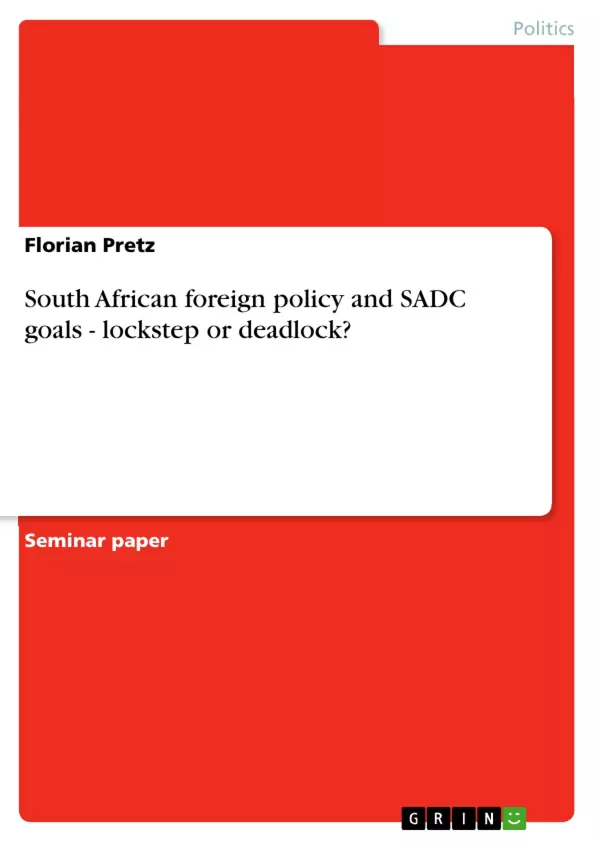The strongest state on the African continent – that is definitely South Africa.
Their economic strength and international acceptance as a representative for
the whole continent established that position. South Africa’s international
reputation as an emerging middle power (Erdmann 2007: 2) enabled the
former Pariah-state to develop a unique foreign policy whose basic values
are shared by most of the powerful states in the world. The importance of a
flourishing African continent and economic as well as political success
especially in Southern Africa was always emphasized by the representatives
of the rainbow nation. According to this position, South Africa joined the
South African Development Community (SADC) after its successful transition
into a democracy in 1994, using this institution for cooperation with the
neighbour-states. But 14 years after the termination of Apartheid questions
regarding South Africa’s foreign policy are raised: In how far plays the SADC
a role in the plans of South Africa? Is SADC really, as often implicated, the
top priority in South Africa’s foreign policy? Does the vision of the institution
and the expressed South African foreign policy go in the same direction?
To answer these questions I will use an historical approach and start with an
overview of the South African foreign policy since 1994. I will identify different
phases, strongly linked to presidency, which will help to understand South
Africa’s current foreign policy. In chapter two I will focus on these current
positions of the government and the national interests. The definition of the
term national interest and its differentiation from foreign policy will take part in
chapter two as well. Chapter three will focus on the SADC with its historical
grown values and visions before a detailed analysis of the main question will
be done in chapter four. By bringing the foreign policy on one side and the
visions and goals of SADC on the other side together, a comparative analysis
can be done. The assignment will conclude with an evaluation of the question
if SADC and South Africa are still fitting together and if the mutual way will
lead to a deadlock or a lockstep towards a prospering future for Southern
Africa.
Inhaltsverzeichnis (Table of Contents)
- Introduction
- The South African foreign policy since 1994 - an overview
- Strategic interests and foreign policy of South Africa today
- The SADC aims, visions, tasks
- South Africa and SADC – walking in the same direction?
- Conclusion
Zielsetzung und Themenschwerpunkte (Objectives and Key Themes)
This analysis aims to examine the relationship between South Africa's foreign policy and the goals of the Southern African Development Community (SADC). It investigates whether the two entities are aligned in their visions and strategies for the region's development.
- South Africa's foreign policy since 1994
- South Africa's national interests and foreign policy priorities
- The aims, visions, and tasks of SADC
- A comparative analysis of South Africa's foreign policy and SADC goals
- Evaluation of the potential for a lockstep or deadlock in the relationship between South Africa and SADC
Zusammenfassung der Kapitel (Chapter Summaries)
The introduction sets the scene by highlighting South Africa's position as the dominant force in the region, its international reputation, and the importance of regional integration.
Chapter one provides an overview of South African foreign policy since 1994, examining different phases linked to presidents Nelson Mandela and Thabo Mbeki. It highlights challenges in defining the country's foreign policy after years of isolation and discusses internal inconsistencies and criticisms.
Chapter two focuses on South Africa's current national interests and foreign policy positions, emphasizing the importance of a flourishing African continent and economic success in Southern Africa.
Chapter three delves into the historical development of SADC, outlining its aims, visions, and tasks.
Chapter four offers a comparative analysis of South Africa's foreign policy and SADC goals, examining whether their visions and strategies align.
Schlüsselwörter (Keywords)
This analysis explores key terms and concepts such as South African foreign policy, regional integration, SADC, national interests, foreign policy priorities, aims, visions, tasks, comparative analysis, lockstep, deadlock, and the African continent.
- Quote paper
- Florian Pretz (Author), 2008, South African foreign policy and SADC goals - lockstep or deadlock?, Munich, GRIN Verlag, https://www.grin.com/document/113402



